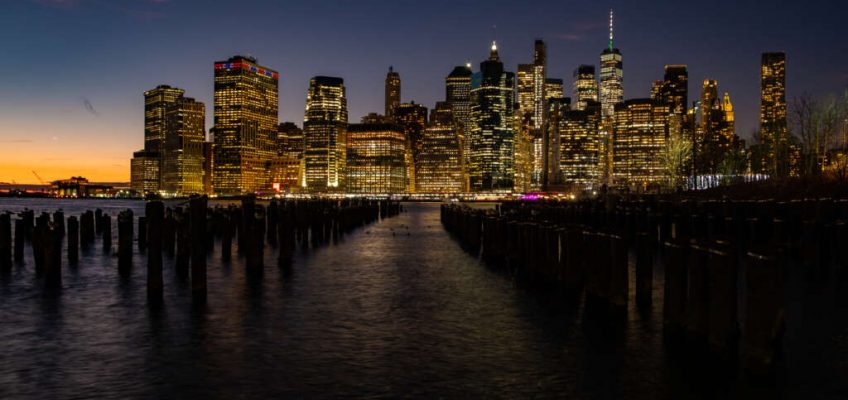“By powering off artificial nighttime lighting during spring and fall migrations, we can ensure that our friends in the sky are kept safe.”
An evening view of the Financial District in Manhattan from Brooklyn Bridge park in Brooklyn. (Adi Talwar/City Limits)
This week is Climate Week, an annual event that brings leaders from business, tech, government, and academia together in NYC to discuss a push to shift the global approach to climate change. 2025’s theme is “Power On”—but we actually need to power off our lights at night to help our feathered friends by passing Int. 0896.
This bill would require privately-owned commercial buildings and large retailers over 4,000 square feet to turn off non-essential lights at night. By powering off artificial nighttime lighting during spring and fall migrations, we can ensure that our friends in the sky are kept safe.
Have you ever been driving and had a car approach with its brights on? Building lights have the same disconcerting and dangerous impact on birds. The bright lights shining from city buildings at night increase the likelihood of these incidents by drawing birds closer to buildings and causing disorientation, which often leads to fatal injuries. Cornell Lab of Ornithology’s research shows that more than 250,000 birds are killed in New York City each year as a result of building collisions, and that is an underestimate.
Failing to protect birds will continue to compound climate change’s threats to biodiversity. Two-thirds of North American birds are already at risk of extinction from climate change. If we allow these preventable deaths to continue, many bird species will be pushed even closer to the brink; the numerous species of plants and predators that rely on birds for their own survival will follow close behind.
Protecting birds also protects New York’s climate resiliency. Birds serve as pollinators, seed dispersers, and natural pest control. The city’s avian pollinators enable many of the 1,250 local plant species to reproduce. When bird populations flourish, urban green spaces flourish, which in turn helps to mitigate and prevent climate change. Their contributions are crucial, as climate change and habitat loss increasingly threaten bees and other native pollinators.
Birds also help combat invasive species, making the city more hospitable for plants and humans alike. Green spaces reduce the urban heat island effect, a phenomenon where dense urban areas like New York City produce and trap more heat, thus experiencing higher temperatures. Lush, green habitats also store carbon, reducing the amount of carbon in the atmosphere and slowing global warming. Yet we can’t reap the benefit s of these green spaces without birds also doing their crucial part to sustain our urban ecosystem.
Birds in Jamaica Bay (Adi Talwar/City Limits)
The City took a small step forward in 2021 when it began requiring City-owned and leased buildings to turn off non-essential outdoor lights during peak bird migration seasons in the spring and fall, as well as requiring occupancy sensors that control illumination. The clear next step is to pass Int. 0896, which would require privately-owned businesses to turn off non-essential lights. In the statehouse, we must also pass the Dark Skies Protection Act (A. 4615), which would further require the shielding of outdoor lights, preserving New York’s clear skies and beloved birds.
These laws advance the health of our climate on multiple fronts. Protecting birds from fatal collisions preserves biodiversity and ensures the green spaces they pollinate will continue to thrive. Shutting off thousands of unnecessary lights will also drastically reduce citywide energy consumption by requiring less fossil fuel to be burned to power the city. Not only would NYC businesses reduce their carbon footprint, but they would also save up to 19% of their overall costs.
Artificial light is also linked to disruptions in your body’s internal clock (circadian rhythm) that is associated with an increased risk of major diseases, from cancer to obesity to Parkinson’s to depression. Nowhere is this truer than in environmental justice communities. Decreasing the amount of artificial light in our skies can not only save the lives of birds, but it can also improve the health of our communities.
In a city of 8.5 million people, New Yorkers are used to coexisting with our human neighbors, but we shouldn’t forget that we also share our streets, skies, and parks with millions of animals. Luckily, a more sustainable, bird-friendly, and healthy New York City is just a flip of the light switch away.
Harvey Epstein is a member of the New York State Assembly representing Manhattan. Kathy Nizzari is founder of the Lights Out Coalition.
The post Opinion: Flipping The Switch And Protecting Our Feathered Friends appeared first on City Limits.


Leave a Reply